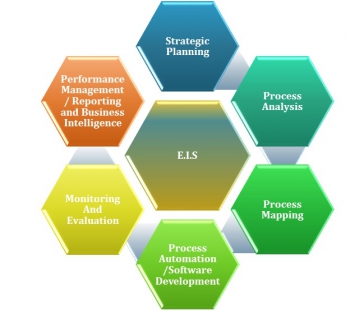The bond between Performance Management and Technology.
As we have seen in our previous newsletters, organizational success is directly affected by the organization’s performance management capability. Therefore, pursuing a strategic approach to managing and optimizing business performance becomes a top priority.
Successful implementation of performance management demands the collaboration between business and IT functions, integrating business information and technology, in order to deliver data-based knowledge and improve the performance of the people and the business.
Organizations cannot advance using outdated tools. On the contrary, effective performance management requires a unified approach built on modern technology, from user access and security to definitions of metrics and key performance indicators.
>> On the business side, this means that there will be a common set of business methods for defining strategy, plans and initiatives.
>> On the technology side, there will be a common method to connect to data sources, the semantic layer and capabilities to author and consume performance-related information.
How is IT and Performance Management integration achieved?
> Organizations must plan and operate using a single unified view of their significant – if not all - data.
> Therefore, having a common platform and common tools at the disposal of all people (employees/users) is very important.
>> In this way, the organization will ensure that common methodologies are used by everyone and, as a consequence, that results are comparable.
>> In addition, work carried out and results produced by individuals are automatically placed in the context of the organization’s strategic goals.
> This unified approach helps to reduce errors in KPI definition and target setting and – most importantly - in actual KPI values calculation. It builds a single, reliable and true picture of organizational and people performance.
> On the contrary, incrementally built disjoint information systems, even though interfaced, pose the risk of – often undetectable – errors and inconsistencies in the results produced. Individual effort is often required to transform results, produced by the systems, into something meaningful for management and - more often than not - spreadsheet intensive work is unavoidable.
> What this means is that ad hoc purchasing or building IT tools for several departments and processes is counterproductive.
> A common working platform that integrates operational processes with performance management needs enhances collaboration, assists decision-making, saves time and keeps the organization focused and on track.
Action is needed
Integration requires understanding, optimizing and aligning processes and their performance to the expectations of the various stakeholders and especially Top Management, who have the responsibility for achieving success.
An assessment of technologies and tools for performance management is not easy. Resistance will be raised and the investment already made will be an inhibiting factor in the change process. Arriving at the best outcome will require strong leadership.
The assessment will require a team consisting of both business and IT professionals – a mix of analysts, managers, directors and CxOs. All people, who have knowledge and understanding of performance management, must participate in determining daily, weekly, monthly and annual reporting, analysis and planning. IT support needed to achieve these should be secured.
In essence, the business processes are studied and the associated information that is relevant to performance management is extracted.

>> What information is needed by each person/ team/ department/ division/ corporate executive for performance management?
>> Which are the information–related inefficiencies?
>> Which information could/should be shared to improve efficiency?
In the light of organizational processes and information needs...
...existing and proposed new technologies must be evaluated to determine their sophistication and capabilities;
...server, administration and security requirements must be assessed;
...the requirements for transition from the current to the optimum state must then be determined;
...cost should be balanced with the benefits gained, including increased efficiency, elimination of redundancies, time saving, fewer errors, possibly lower server costs etc.
Is no action possible?
>> Any change that will impact existing business processes is risky and difficult.
>> On the other hand, ignoring the problem doesn’t make it disappear. It can easily get out of control.
Important questions must be asked:
- Where could organizational latency lead?
- What would be the impact of erroneous performance results reaching the management?
- Who is going to be held responsible for inaccurate decisions that relied on the disparate systems and silos of information?
Do remember:
Unifying and streamlining performance management is definitely a worthwhile, overdue investment when targets have been missed, competitors have taken over, profitability has fallen, employee morale has dropped…
Act proactively! We all know that prevention is the best remedy, we just sometimes forget…
8.4.2016


